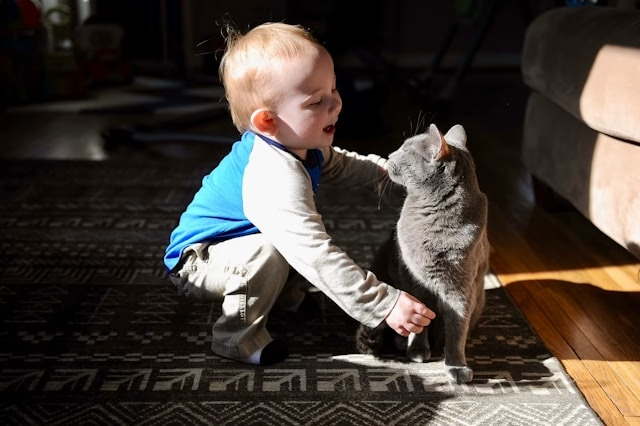Introduction: The Mystery Behind a Cat’s Gaze
If you live with a cat, you’ve probably wondered: do cats love or tolerate us? The aloof stare from the windowsill, the selective moments of affection, the sudden retreat after a brief cuddle, all of these fuel the debate. Cats can appear distant compared to dogs, who often display loyalty and love openly. But perhaps the answer doesn’t lie in comparing cats to dogs. To understand them, we need to look at their wild relatives: lions.
Among all the wild cats, lions are the most social. They live in prides with structured bonds, cooperation, and clear displays of both affection and tolerance. By studying lion behavior, we can uncover surprising truths about what our house cats may really feel for us.
Lions: Social Bonds in the Wild
Lions are unique among big cats. While tigers and leopards prefer solitary lives, lions thrive in groups. A pride is usually made up of related females, their cubs, and a coalition of males. Within this unit, lions show warmth and closeness in ways that look surprisingly familiar. They rub heads, groom each other, and rest side by side in the shade.
But lions also show tolerance rather than affection. Not every lion in a pride gets along perfectly. Tensions arise around food or mating, and sometimes members avoid one another. Yet the pride endures, because survival depends on cooperation. Affection and tolerance exist side by side, both are forms of bond.
Domestic Cats: Solitary or Social?
For years, scientists described domestic cats as solitary. Unlike dogs, descended from pack-living wolves, cats evolved from the African wildcat, which typically lives alone. Yet domestication changed the story. Where food is abundant (near farms, villages, or human homes) cats gather in colonies. In those groups, they form relationships that look much like mini prides.
Cats groom each other, sleep in piles, and defend territories together. But they also keep personal boundaries. Affection is offered on their terms, not demanded. What seems like aloofness to us may actually be a balance of closeness and tolerance.
Love in a Cat’s Language
Still, tolerance plays a role. A cat that allows you into its personal space without aggression is offering something valuable. In the wild, lions often lie side by side without grooming or interaction, simply coexisting peacefully. This tolerance is a form of trust.
When your cat sits nearby without touching, follows you from room to room, or shares space in silence, it mirrors lion behavior. Affection and tolerance are not opposites; together they create a spectrum of relationship.
What Lion Prides Teach Us About Cats at Home
By looking at lions, we see that love in feline societies is not constant cuddling or loyalty expressed in obvious ways. Instead, it is a mix of closeness, cooperation, and respect for boundaries. Domestic cats, shaped by both wild ancestry and human companionship, mirror this balance.
Like lions grooming each other, cats show affection through licking, head bumps, and resting together. Like lions lying in the same shade without touching, cats show tolerance by sharing space without demanding attention. Like lions defending their pride, cats may guard their home and humans from perceived threats, even if subtly.
Understanding these parallels changes how we see our pets. A cat does not need to act like a dog to show love. Its own language of affection and tolerance is just as valid.
Do Cats Love Us?
The scientific answer leans definitively toward yes. A behavioral study from Oregon State University found that over 64% of cats form secure attachment bonds with their owners, mirroring the attachment patterns seen in dogs and even children. This challenges the stereotype that cats are aloof and simply tolerate us.
Even more revealing, biological research has confirmed that cats experience real hormonal responses during human interaction. A study measuring cats’ urinary oxytocin levels found that after social contact, oxytocin significantly increase, suggesting that cats recognize and value these interactions on a biological level.
These findings show that while cats might not leapt into our arms, their emotional and hormonal responses point to something deeper than mere tolerance. Their love might be quieter, but no less real.
How to Strengthen the Bond With Your Cat
If you want to build trust and affection, take lessons from the pride. Respect boundaries, offer closeness without forcing it, and recognize tolerance as a form of connection. Slow blinks, head bumps, gentle brushing, and interactive play all strengthen the bond.
In a pride, bonds are maintained through small, repeated gestures. The same applies at home. Every slow blink, every touch, every moment of shared space is a thread in the fabric of love.
Conclusion: Love, Tolerance, and the Wild Heart of Cats
So, do cats love or tolerate us? The truth is both. Like lions in a pride, domestic cats balance affection with independence. Their love may be quieter, their tolerance less flashy, but together they create bonds that endure.
The next time your cat curls up near you, remember: in the language of lions, that silent closeness is not indifference. It is love, spoken in feline terms, a bond that bridges the savanna and your living room.
Related Posts:
Do Cats Still Hunt Like Lions? Instincts You See Every Day.
Why Do Cats Knead? The Wild Nesting Instinct You Can Redirect Today.


